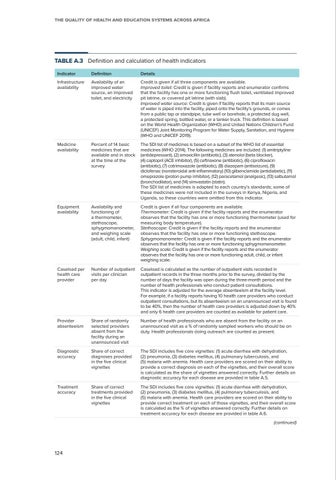The Quality of Health and Education Systems Across Africa
TABLE A.3 Definition and calculation of health indicators Indicator
Definition
Details
Infrastructure availability
Availability of an improved water source, an improved toilet, and electricity
Credit is given if all three components are available. Improved toilet: Credit is given if facility reports and enumerator confirms that the facility has one or more functioning flush toilet, ventilated improved pit latrine, or covered pit latrine (with slab). Improved water source: Credit is given if facility reports that its main source of water is piped into the facility, piped onto the facility’s grounds, or comes from a public tap or standpipe, tube well or borehole, a protected dug well, a protected spring, bottled water, or a tanker truck. This definition is based on the World Health Organization (WHO) and United Nations Children’s Fund (UNICEF) Joint Monitoring Program for Water Supply, Sanitation, and Hygiene (WHO and UNICEF 2019).
Medicine availability
Percent of 14 basic medicines that are available and in stock at the time of the survey
The SDI list of medicines is based on a subset of the WHO list of essential medicines (WHO 2014). The following medicines are included: (1) amitriptyline (antidepressant), (2) amoxicillin (antibiotic), (3) atenolol (beta blocker), (4) captopril (ACE inhibitor), (5) ceftriaxone (antibiotic), (6) ciprofloxacin (antibiotic), (7) cotrimoxazole (antibiotic), (8) diazepam (antiseizure), (9) diclofenac (nonsteroidal anti-inflammatory) (10) glibenclamide (antidiabetic), (11) omeprazole (proton pump inhibitor), (12) paracetamol (analgesic), (13) salbutamol (bronchodilator), and (14) simvastatin (statin). The SDI list of medicines is adapted to each country’s standards; some of these medicines were not included in the surveys in Kenya, Nigeria, and Uganda, so these countries were omitted from this indicator.
Equipment availability
Availability and functioning of a thermometer, stethoscope, sphygmomanometer, and weighing scale (adult, child, infant)
Credit is given if all four components are available. Thermometer: Credit is given if the facility reports and the enumerator observes that the facility has one or more functioning thermometer (used for measuring body temperature). Stethoscope: Credit is given if the facility reports and the enumerator observes that the facility has one or more functioning stethoscope. Sphygmomanometer: Credit is given if the facility reports and the enumerator observes that the facility has one or more functioning sphygmomanometer. Weighing scale: Credit is given if the facility reports and the enumerator observes that the facility has one or more functioning adult, child, or infant weighing scale.
Caseload per health care provider
Number of outpatient visits per clinician per day
Caseload is calculated as the number of outpatient visits recorded in outpatient records in the three months prior to the survey, divided by the number of days the facility was open during the three-month period and the number of health professionals who conduct patient consultations. This indicator is adjusted for the average absenteeism at the facility level. For example, if a facility reports having 10 health care providers who conduct outpatient consultations, but its absenteeism on an unannounced visit is found to be 40%, then the number of health care providers is adjusted down by 40% and only 6 health care providers are counted as available for patient care.
Provider absenteeism
Share of randomly selected providers absent from the facility during an unannounced visit
Number of health professionals who are absent from the facility on an unannounced visit as a % of randomly sampled workers who should be on duty. Health professionals doing outreach are counted as present.
Diagnostic accuracy
Share of correct diagnoses provided in the five clinical vignettes
The SDI includes five core vignettes: (1) acute diarrhea with dehydration, (2) pneumonia, (3) diabetes mellitus, (4) pulmonary tuberculosis, and (5) malaria with anemia. Health care providers are scored on their ability to provide a correct diagnosis on each of the vignettes, and their overall score is calculated as the share of vignettes answered correctly. Further details on diagnostic accuracy for each disease are provided in table A.5.
Treatment accuracy
Share of correct treatments provided in the five clinical vignettes
The SDI includes five core vignettes: (1) acute diarrhea with dehydration, (2) pneumonia, (3) diabetes mellitus, (4) pulmonary tuberculosis, and (5) malaria with anemia. Health care providers are scored on their ability to provide correct treatment on each of those vignettes, and their overall score is calculated as the % of vignettes answered correctly. Further details on treatment accuracy for each disease are provided in table A.6. (continued)
124


